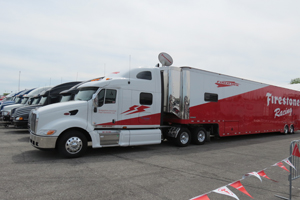Trucks Have a Central Role in Indy 500 Hauling Cars, Tires for Famous Race

This story appears in the June 9 print edition of Transport Topics. Click here to subscribe today.
INDIANAPOLIS — The first thing you notice when entering Indianapolis Motor Speedway is its size. The banked track at 2½ miles around is 10 times as large as a typical football field and more than twice as big as most horse-racing tracks.
Inside the gates are a pond, a campground, a couple of huge concert fields, a separate Grand Prix track and four holes of an 18-hole golf course.
Also, there are the race cars, garages and the famous “Gasoline Alley” — although Indy-class cars now run on E85 fuel, a mix of 85% ethanol and 15% high-test racing gasoline.
And there are trucks that bring in the goods for the Indianapolis 500 — the world’s most famous car race, held every year on Sunday of Memorial Day weekend and mecca for 200,000-plus fans.
Firestone Tires, for example, brought in 15 trailer-transporters and about 6,500 tires for this year’s race. They included two Firestone Racing-logo trailer-transporters that attend every race event — one for equipment for mounting and balancing tires, and the other for the company’s engineering, management and public relations offices.
The 53-foot trailers have rollup doors because they are often parked so tightly that there is no space for swing doors, Firestone officials said.
Firestone, which gave behind-the-scenes access during race weekend to Transport Topics and other transportation journalists, provides all the tires for Indy cars.
That means “there’s no competitive advantage” among drivers, Dennis Boley, Firestone’s senior compounder, told reporters during a garage tour on “Legends Day,” the day before the race.
The tires are light: 18 pounds in the front and 21 pounds in the rear, and the wheels are a
magnesium-aluminum alloy. During the race, pit crews change all four tires and dump fuel into 22-gallon tanks in less than 10 seconds.
The cars, which get about 4 mpg, make six or seven pit stops in a typical 500-mile race, Jon Bouslog, team manager for Penske Racing, said during a tour of Team Penske’s garage.
The race was the 98th running and had no cautions or crashes in the first 150 of its 200 laps. There were 34 lead changes and 11 different leaders.
Ryan Hunter-Reay, of Fort Lauderdale, Florida, became the first American to win the Indy 500 since 2006, edging three-time winner Helio Castroneves of Brazil by 0.06 second after passing him in dramatic fashion on the backstretch of the 197th lap and holding him off down the stretch by about a car length.

